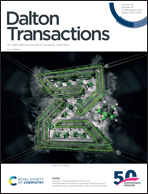Sometimes less is more—the impact of the number of His residues on the stability of Zn(ii)–SmtB and BigR4 α-5 domain complexes†
Abstract
The increasing number of antibiotic-resistant pathogens has become one of the major health problems of modern times, including infections caused by Mycobacterium tuberculosis. One of the possible mammalian immune system responses to mycobacterial infection is the increase of the zinc(II) concentration in phagosomes to a toxic level. The mycobacterial SmtB protein belongs to the family of ArsR/SmtB transcription regulators. In the presence of high concentrations of metals, SmtB dissociates from DNA and activates the expression of metal efflux proteins. In this work, we focus on the α5 zinc(II) binding domains of SmtB/BigR4 proteins (the latter being the SmtB homolog from non-pathogenic M. smegmatis) and two mutants of BigR4. We will be taking a closer look at the coordination modes and thermodynamic properties of their zinc(II) complexes. The study points out the specificity of metal–ligand interactions and describes the effect of mutations on the coordination properties of the studied systems. The stabilities of the zinc(II) complexes were determined by potentiometry. The coordination sites were determined by NMR experiments and DFT calculations. The comparison of complex stabilities reveals that the Zn(II)–BigR4 species are more stable than the Zn(II)–SmtB complexes. His mutations strongly affect the stability of the complexes and the coordination modes of the metal ion. Exchanging one of the histidines for alanine causes, surprisingly, an increase in the stability of zinc(II) complexes with the studied domain. This was confirmed by potentiometric and DFT methods. This work can be considered as a bioinorganic introduction to the discovery of new strategies in M. tuberculosis infection treatment based on zinc(II)-sensitive mechanisms.



 Please wait while we load your content...
Please wait while we load your content...